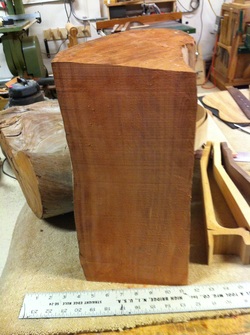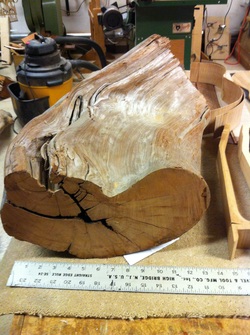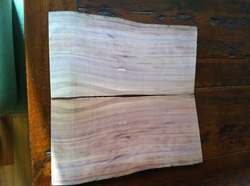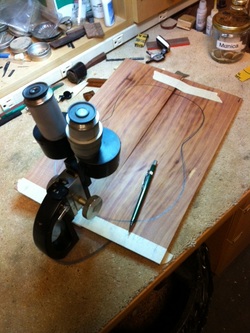TODAY I WENT to my storage unit where I keep my precious supply of wood. I am heading for Lopez Island next week to visit Bruce Creps of Notable woods. I hope to buy some nice wood and also to have him saw some wood for me on his professional bandsaw that is reputed to be excellent. I hate to saw good wood on my band saw as I have a hard time sawing it straight and I hate to waste wood. I was getting out some of the wood that I want him to saw for me.
I found the two large pieces of Juniper that I had beach-combed from Orcas Island many years ago. One of them is quite large and quite straight. Back at the shop I thought I would try to rough it into shape for sawing. To my vast pleasure I was able to saw off two very nice pieces. It sawed easily and straight. I ran them through my sander and have been admiring them ever since. I have a hunch I have a treasure here.
I found the two large pieces of Juniper that I had beach-combed from Orcas Island many years ago. One of them is quite large and quite straight. Back at the shop I thought I would try to rough it into shape for sawing. To my vast pleasure I was able to saw off two very nice pieces. It sawed easily and straight. I ran them through my sander and have been admiring them ever since. I have a hunch I have a treasure here.

This piece has nice straight grain and I was able to quarter saw it getting a fine ukulele soundboard that will be book matched. Most of this wood is gnarly and twisted so this is probably the only really good tonewood stock but I think this might be quite good. It is very pretty, hard and dense and incredibly tight grained. The two pieces I have sawn and sanded have a very nice tap tone ring. I am intrigued with making ukuleles of Pacific Northwest woods and this Juniper might just turn out to be outstanding.
I also am taking some Pacific Yew to be sawn by Bruce. I have had it for years and never used it but it is clear, straight and hard, the indians used it for bows. Also found an amazing piece of Douglas Fir with beautiful grain, some Redwood that was paneling in a friends bathroom that is being remodeled. I will be having some fun building experimental tenors with these western woods. What could be better, Tiger stripe Big Leaf maple backs and sides, and Cedar, spruce, Juniper, Fir or Yew tops. All western, all beautiful
I also am taking some Pacific Yew to be sawn by Bruce. I have had it for years and never used it but it is clear, straight and hard, the indians used it for bows. Also found an amazing piece of Douglas Fir with beautiful grain, some Redwood that was paneling in a friends bathroom that is being remodeled. I will be having some fun building experimental tenors with these western woods. What could be better, Tiger stripe Big Leaf maple backs and sides, and Cedar, spruce, Juniper, Fir or Yew tops. All western, all beautiful

Here is the largest piece. This was the base of the tree, lots of cracks and twists. I don 't know that I can use it, but the next 20 inches up the trunk is straight and solid and what I am using. I show you this piece to show you the size of the tree, It measures 13 inches. This would be a large juniper. They grow slowly in the dry and rocky coastline of the islands, starved for water and nutrients.

Here are the two book matched pieces that I cut off on my bandsaw. I ran them through my thickness sander to see how they would shape up. I am thrilled. Very pretty wood, no blemishes , a couple of little character marks, incredibly tight grain. I will make these into a top for the custom tenor that I have begun working on. This will be a better top than the juniper top shown in the blog a couple of days ago, two piece, prettier wood. better tap tone. Dave you will be happy with todays labors.

I trimmed the pair and scribed the tenor shape on them, Then I got curious about the age of the wood. I decided to count annual rings. I tried with my 10 power glass but the rings were so tiny I could not count them, I finally got out my field microscope from my Entomology days and the truth was revealed. There are 321 growth rings across one half of this uke top. I am counting from the pencil mark to the center joint, I thought the wonderful cedar I use on my ukes was tight grained at 400 growth rings in 9.5 inches. This juniper has 642 rings in that width, Incredible!! I estimate that the tree which was 7 inches from heart to outer growth ring was about 419 years old when the cliff that it had grown on collapsed onto the beach below. that means the seed it grew from germinated in 1594. Will Shakespeare was in his prime years about then. Maybe we ought to name this first Juniper Uke 'Shakespeare"
